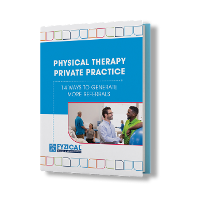How to Open a Physical Therapy Practice
Discover the three major phases that all PT's must go through in the journey to opening their own practice. In the ultimate guide to opening a physical therapy practice, you will discover the process from start to finish, and solutions to overcome obstacles along the way! Read along, or download the guides and take them with you!

Pre-Opening and Planning:
What to Know & Do Before You Start Your Physical Therapy Practice

Setting Up Your Practice for Success
The Setup & Opening Process for Your New Physical Therapy Practice
How to start a physical therapy practice
So, you want to know how to start a physical therapy practice?
If you’re like most physical therapists who want to open a practice, you may be motivated to get started but have an overwhelming number of questions about the process. In our three-guide series, we will help walk you through the three stages of opening a physical therapy practice; before you open, setting up your practice, and maximizing your success after you open.
There are no shortcuts when it comes to starting your own business, and having a strong foundation will be critical to the success of your new physical therapy practice. Here you will learn everything you need to know – from the initial planning stages to outfitting your business, to tracking key performance metrics for the ultimate financial success. With a clear plan and hard work, you can successfully transition from a physical therapist working for someone else, to the proud owner of your very own private practice.
While private practice ownership won’t be the right choice for everyone, it can be a very rewarding endeavor. You must be prepared to work long hours and perform several roles outside of physical therapist when you get started. For you to succeed, you’ll first need to develop a plan. How to Start a Physical Therapy Practice: A Guide to Pre-Opening Your Practice, will help you through the initial planning process for how to start a physical therapy practice.
Part 1: Table of Contents
- Your Target Market
- Your Competition
- Stand Out: Differentiate Your Practice
- Financing Your Practice
- How to Develop a Business Plan
- Getting Your Paperwork In Order
- Secure Your Financing
Define Your New Practice
Before you can even begin to set up a PT practice, you’ll first need to understand who your patients will be. Three major categories will intersect to determine if your physical therapy business will be positioned to attract patients. Those factors are your target market, your competition, and your niche specialties.
Your Target Market
Who are your customers? By their very nature, physical therapy clinics are location-based. This means that when considering the type of patients you want to attract, you will want to consider the concentration of those types of patients within a radius of your desired location. You’ll want to consider these key questions as you evaluate who your target customer is within your community:
-
Who needs physical therapy services within the community?
An analysis of your competitors may give insight into a population of the community that is currently underserved. For instance, there may not be a pediatric physical therapist in the community, but there are several large school districts nearby which indicates there is a great pediatric population in the community. Part of finding success as a physical therapy owner is finding untapped demand in your community. -
What types of therapy will they need?
For example, a community that skews geriatric could benefit from balance therapy services, while a community that has a major university and a population that is skewed younger may benefit from sports rehabilitation PT services. Finding the right mix of services can help you differentiate your practice while providing excellent care to those in your community.
-
What referral sources are within the community that may tie into the type of therapy you offer?
You will need to develop relationships with other providers who can refer you for physical therapy services. An orthopedic surgeon may be a good referral source for sports injury rehabilitation, while an ENT would be a great referral source for balance and vestibular services. Referral sources help you grow your practice so understanding the sources in your community is key to a thriving practice.
Before you can even begin to set up a PT practice, you’ll first need to understand who your patients will be. Three major categories will intersect to determine if your physical therapy business will be positioned to attract patients. Those factors are your target market, your competition, and your niche specialties.
Know Your Competitors
When choosing a location for your practice, look at how many other physical therapy businesses exist in the area. Don’t forget to consider hospital systems and concierge practices as well. You’ll want to examine the following competitor traits within a specified radius of your prospective location:
How many direct competitors are out there?
- How big are their practices?
- How long have they been in business?
- How are their businesses structured?
- How have they been successful?
- What do they specialize in?
Once you have gathered the data for the location you are interested in, you need to determine if there is any additional demand for the services you will offer, or if that location is already saturated. If it is, select a new location and repeat the competition audit.
Choose Your Niche
Once you have considered your pool of potential patients and evaluated your competition, you should determine your specialty. What services will you be able to provide that will set you apart from your potential competitors? Choosing a specialty gives you a competitive edge. Consider the following before you make your choice:
- What type of PT do you enjoy performing?
- Is there market potential for your area of interest?
- What types of patients do you enjoy working with?
- Does your experience help you serve patients within this specialty?
- Are there any PTs who have built a practice successfully around this specialty?
- How many of the competitors in your area will directly compete with your niche?
An area of specialty that meets an unmet need in the community is a powerful indicator of potential success for a new physical therapy clinic. If you have already decided on your area of specialty, you can instead look for an area that has a growing demand for those services.
Financing Your Physical Therapy Practice
The most eye-opening part of the process for opening a PT practice is often the amount of capital required. This is the biggest hurdle for new practice owners, and sometimes where the dream of opening a practice ends. Likely, business finances weren’t part of your doctorate education, yet it’s fundamental to opening a private practice. The experience can be more manageable when broken down as follows;
Solo Leadership or Business Partnership?
Do you plan to run your business on your own or with a partner? There are pros and cons to both. A partner can often bring a skill set to that table that you’re missing – such as business acumen or financial support. A partnership could allow you to achieve greater success than going it alone. However, there are some definitive risks to forming a partnership – consider the loss of total control, differences of opinion, and risk of your relationship if you partner with friends or family. Before entering any partnership, the APTA highly recommends seeking legal counsel to protect both parties. Solo practice, on the other hand, allows you the freedom to make all the decisions, but you also take on all the debt and all the risk. Here are a few questions you could ask yourself that may help you decide which option is best for you;
- Is your skillset well balanced? Are you both an outstanding clinician and good at handling complicated finances and launching successful marketing campaigns?
- Can you implement and maintain technology?
- Are you a big picture or daily details-oriented person? If you don’t do both, who will?
- Do you prefer to work with a team or on your own?
- Do you know exactly what you want your practice to be like?
- Are you confident in your skillset and abilities or would it be best to have a partner that complements you?
Selecting a Physical Therapy Business Model
The option to “choose a business model” wasn’t always a part of opening a physical therapy clinic. There used to be just one traditional model that every clinician defaulted to – an insurance-based business. But, as the industry evolves and the era of choice is upon us, physical therapy practice owners have more business model options than ever before. Below, we sum up four of the most popular options.
Cash-Based Physical Therapy Practice
Cash-based clinics are on the rise, and there that comes as no surprise since insurance can be such a hassle for practice owners. A cash-based practice may relieve you of the claim’s submission process, but some of your patients may still want to submit for reimbursement directly to their insurance company so you will need to provide invoices that detail the charges. Ultimately your documentation and billing practices must lead to patients getting reimbursed by their insurance or they may not continue treatment with you.
This model can also allow you to spend more time per visit with each patient and decrease the number of visits per patient overall. You will have to overcome some hurdles with patient perception and educate them on the benefits of a cash-based practice. There are also some specific Medicare considerations for cash-based practices, so do your research. Before choosing this model, contemplate your community demographics and survey how other cash-based businesses (e.g. massage, chiropractic, acupuncture) are performing in your area. (it seems this needs more context to wrap it up. Once you survey other businesses, then what?)
You might want to check out this blog on 5 things you should consider before you open a cash-based physical therapy practice.
Insurance-based Physical Therapy Practice
This is the most traditional business model for physical therapy practice owners. PTs contract with major insurance companies to provide services to insurance beneficiaries at an agreed-upon contract reimbursement rate. Most of the cost of services falls to the insurer, while the patient may pay a modest copay. As insurance reimbursement continues to decline, more PTs are opting to supplement this model with the addition of cash-based services such as massage and laser therapy, to generate additional income. While often a bigger hassle and more overhead for the PT, insurance-based models are still preferred by the patient majority because of their smaller out-of-pocket cost.
Multi-Disciplinary Physical Therapy Practice
With a greater emphasis on collaborative care than ever before, providers across various health professions are teaming up to deliver holistic care options to their patients. The model is designed to increase patient satisfaction, improve patient experience, and reduce the overall cost of care – both monetarily, and through the time savings not needing to visit multiple offices. This model also allows for more efficient referral processes and improved health outcomes through provider collaboration.
Concierge Physical Therapy Practice
Subscription-based concierge care isn’t a new concept, but it’s helping many physical therapy business owners boost their profitability. In this model, patients pay an annual or monthly fee to access all services within the practice. PTs who use this model love it because it helps their patients avoid preventable illnesses and removes insurance dependence and copays while also decreasing long wait times. It’s a recurring revenue model and boosts the perception of the physical therapist as a primary care provider.
Develop Your Business Plan
Now that you’ve thoroughly researched your market, identified your competitors, and you’ve chosen a niche focus and a business model – you must secure financing. However, you’ll need a strategic business plan first. Remember, you will be held accountable for the projections and proposals that it contains, especially if you plan to raise the money for financing your practice. Plan strategically, this is the document that will outline your optimal path to achieve future goals and show your awareness of potential roadblocks. Your business plan must include:
Executive Summary
Elevator Pitch
Your clinic’s mission and value statements
Analyze
5-Year Strategic Plan
Marketing Plan & Budget
Getting Your Paperwork in Order
A new business requires a lot of important documentation before you will secure financing, much less open your doors. Stay organized from the beginning and keep hard copies of everything in a safe place. The following is a comprehensive punch list of the documentation you’ll need for your business:
- Check your state’s website for any state-specific requirements for opening and operating a business
- Set up a business entity - LLC, PLLC or PC, Partnership, Corporations, Non Profits, Sole Proprietorship
- Claim a business name – be sure to check for online availability, you don’t want to open a business and find that the web address is already taken and well established.
- Open a business bank account
- Apply for an Employer Identification Number (EIN)
- Retain a CPA or accountant and select a calendar or fiscal tax year to pay based on
It’s always good advice to speak with an attorney who specializes in private practice law when setting up your new business. They will also be able to help advise you on tax implications and fees for small businesses in your state, city, and county.
Secure Your Financing
With a comprehensive business plan in place, you can now begin the process of securing funding to start your practice. The startup cost for a physical therapy practice varies based on your location, specialty, and size so it’s difficult to give a blanket estimate of cost, but you’ll want to consider the following to understand how much you will need to
fund your business endeavor:
- Cost of state, location, and/or regional
business permits - Rent/Mortgage and Utilities
- Equipment
- Furnishings
- Software – EMR, Scheduler, Billing, Administrative, Payroll
- Personnel – Labor costs and benefits
- Insurance – general and liability
In addition to determining the costs above, you will need to prepare four essential documents before you head to the bank for financing.
- Your business plan
- Financial projections
- Personal financial statement
- Professional references
Finally, you will select a lender. Choose a bank that has experience working with healthcare providers, many new practice owners work with the Small Business Administration (SBA) to secure their financing. Another option is a local bank or credit union. Evaluate the terms of your lending agreement very carefully and try to secure more than one offer before you ultimately select your lender. Compare these offers and choose the one that benefits you and your business the best.
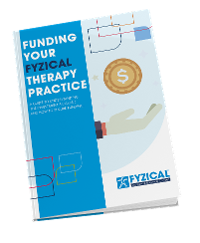 Need additional guidance funding your new physical therapy practice?
Need additional guidance funding your new physical therapy practice?
This was part one in a series of three guides that help teach you how to open your own private physical therapy practice. This is the initial foundation for starting your new physical therapy practice.
In part two, you learn how to leverage the research you performed in this stage to finalize your practice location, understand lease negotiations, the process of getting credentialed with insurance providers, as well as staffing and outfitting your practice.
This is the comprehensive handbook that will help you understand the setup and pre-opening procedures for your new physical therapy practice, check it out here!
How to set up and open a new physical therapy practice
Part 2: A beginner's guide to the setup and pre-opening process for a new physical therapy practice
In part one we discussed the planning and pre-opening stage for starting a physical therapy practice. If you haven’t had a chance to read that guide, check it out here.
In part two of this series, you will learn how to leverage the research you performed in part one in order to select and finalize your new physical therapy practice location. You will also walk away understanding key strategies for lease negotiations, the process of becoming credentialed with insurance providers, as well as understanding what it takes to staff your new practice, select and purchase equipment and furnishings, all for your new physical therapy business!
The ultimate guide to pre-opening: How to set up and open a physical therapy practice
Get the tips that help new physical therapy practice owners find the right location, negotiate their leases, and begin the PT credentialing process. Also includes knowledge for staffing your practice, space design, and navigating equipment selection!
Part 2: Table of Contents
- Finalize Your Physical Therapy Practice
- Lease Negotiation
- Credentialing
- Staffing Your New Physical Therapy Practice
- Setting Up Your Practice
- Equipment Tips
Legal Implications
Finalize Your Practice Location
Referral Providers
Number of People that Live & Work in the Community
Reimbursement Rate
Drive times
The proximity of Competition
Physical Barriers
Cultural & Psychological Barriers
Looking for More Information on Location Selection for Your New Physical Therapy Practice?
Site selection is only one piece of the puzzle when it comes to the success of your physical therapy practice. Besides geographic location, you must consider property-specific conditions that will impact your business, like:
-
- Clinic and Signage visibility
- Size of the Space – Is there room to grow?
- How many practice rooms are there
- Cost per square foot
- Available parking
- Handicap Accessibility
- Restrooms
- Easy ingress/egress
Lease Negotiation
- Parking - for clients and employees
- Signage – Is there a signage provision in the lease?
- Exclusive-Use Clause – you don’t want another PT clinic to open in your lot!
- Option to Renew Clause
- Restore the Premises’ clause – do everything you can to negotiate this clause out of your lease agreement
- Negotiate a cap on any personal guarantees
- Flexible ‘Assignment to Lease’ clause – if you sell your business before your lease ends, you want to be able to assign your lease to the new owner.
- Tenant Improvement Allowance – this
- allowance means the landlord is fronting the cash to pay for your initial renovations. $20-$30 per square foot is a good rate.
- Ask for an Extended Fixturing Period –
- time to renovate your space before you have to pay rent. A good goal is 3 months.
Getting Credentialed
- Tax ID number
- Malpractice Insurance - Every health insurance company will ask for a copy of your malpractice insurance declarations page. Make sure your limits match or exceed the amount listed by the insurance network contract.
- A National Provider Identifier (NPI) To register for your individual NPI, go here https://nppes.cms.hhs.gov/#/. It’s important to have your business tax ID established before you get credentialed as any change to the tax ID number or billing structure will force you to re-credential and you will have to begin the entire process all over again.
- Have an Established Clinic Location (Your Business Address) Register with Medicare Per the Medicare Benefit Policy Manual, Chapter 15 Section 40.4 states that physical therapists in independent practice cannot opt out. You must register as either a participating or nonparticipating provider. Completed Your CAQH Application A multitude of insurance companies use one application for credentialing called ‘CAQH ProView’ to get your provider information. You can fill out your CAQH application here. Save yourself time and complete the application now – the process can take up to 2 hours, so set aside an appropriate amount of time and scan in your tax, malpractice, and NPI documentation ahead of time.
Staffing Your Practice
- Office Manager/Reception – Performs clerical responsibilities, schedules patients, client intake, and insurance knowledge.
- Owner – That’s you! You’re now responsible for tracking and managing the key performance metrics of your business and all financials of the business.
- Clinical Director/DPT – Most likely this is also your role! This person oversees the day-to-day operations, hiring, training of new clinical staff, all initial evaluations, and discharge.
- Physical Therapy Assistant – This role is to assist the DPT, and will perform all PT activities outside of initial evaluations and releases.
- Sales/Marketing Representative – This role executes your marketing plan and is a critical bridge between referral partners and your practice. Their responsibilities will include networking and marketing activities that bring new patients into your business.
Create a Memorable Experience
Design Your Space
Purchase Equipment
Rent
Work Smarter
Think Smaller
Shop Online
- Assess the types of patients you plan to see primarily and what the diagnoses and treatment options are.
- Create a list of the most critical equipment for each category above
- Assess the versatility of each piece of
equipment and grade it on a scale of 1-3 - Rate each piece of equipment on a scale of 1-3 for importance in the treatment
- Choose only the highest-rated pieces in each category to get started
also have:
- Testing & Measuring Devices – neurological testing instruments, video analysis hardware and software, Dynamometers, etc.
- Basic Modalities – Small freezer and ice packs, massage cream, hydrocollator with hot packs, traction unit, table, vaso pneumatic compression device, etc.
- Educational Materials – anatomical models, skeleton, poster, tablet for patient education.
After you open: how to maximize the value of your new physical therapy practice
In part one of this series, you learned about the pre-opening process. If you missed it, check it out here. In part two, you finalized your practice location, and learned how to set up and equip your new practice before you opened your doors – check that out here if you haven’t seen it yet [link]. In the final part of this series, you will learn what you need to do as a new practice owner to achieve maximum success in the physical therapy private practice industry. From marketing planning to software selection, and understanding key performance metrics in the business, this final guide will help you get the most out of your new practice.
Did you know that approximately 50% of small businesses fail after five years in business? This is according to the U.S. Bureau of Labor Statistics as reported by Fundera. As a new owner who has recently opened its doors, you may be feeling like you can finally take a moment to catch your breath, but you still have a lot of work ahead of you. Opening the doors to your new practice is only the first step to success in the physical therapy industry. Below, learn how to maximize your value as a practitioner and how to market your practice effectively in your community to keep patient flow strong, and avoid being a statistic.
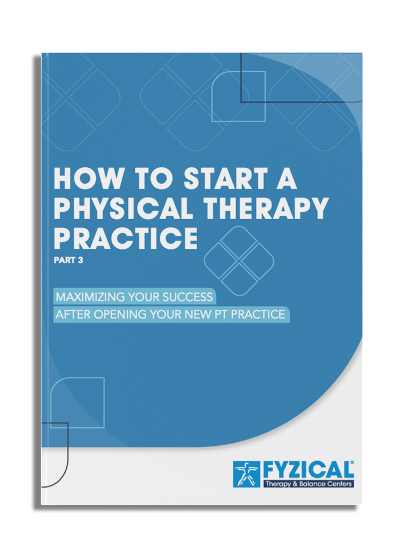
A guide to maximizing your success after opening your new PT practice
What to do after you open your physical therapy practice. In this guide you'll discover tips that help new PT practice owners market their new practice. Learn how to acquire and nurture referral relationships, choose the right software for your practice and determine your success through measurable metrics that matter!
Part 3: Table of Contents
- Marketing Your New Physical Therapy Practice
- Your Digital Practice
- Acquire & Nurture Referral Relationships
- Choosing the Right Software
- Measuring Success - Metrics + KPI's
Marketing Your New Practice
Patients have many options when it comes to choosing their PT, so you’ll need to give them plenty of compelling reasons to pick you over another practitioner. The key to this lies in your marketing plan. What most practice owners don’t realize is that continuing to nurture their current patients is just as important as getting your business name in front of new patients, and in the following section we will address some of the ways you can begin marketing your new practice so that you can grow and maintain a steady patient flow.
As we have established, marketing is critical to your success. To develop a strategy that will bring the patients you want to work with into your business, you will need to focus on attracting and keeping patients who need your services. This requires an approach that crosses multiple inbound marketing channels, and the first thing you need to do is define the following:
Your Target Audience – As a physical therapy practice, you will market to two major client segments for most business models: referring physicians and consumers.
Strategies to Reach Your Target – What will you do to get your name in front of your patients? There are several methods of marketing, and you’ll need to decide what is best suited to you.
Owned Media is any marketing you have direct control over or own the responsibility for. This kind of marketing is great because there is a minimal monetary investment and you maintain full control, but it can require a hefty time investment to achieve success. Examples of this type of media marketing are patient and referral email marketing, social media pages, Google My Business listings, your website, and blogs.
Earned Media is the awareness that you receive rather than broadcast yourself, such as public relations and third-party validation. This is often the lowest monetary investment but does require nurturing relationships, your time, and typically something unique to activate it. Examples of this type of media marketing are conferences and speaking engagements, editorial pieces, press releases, newspaper articles, live segments from local news sources.
Paid Media is marketing that you pay to activate, and it includes both traditional and digital media. Most new business owners think of this type of marketing first. This strategy has a wide audience reach and is less time-intensive than other forms of marketing, but conversely, it is more expensive and still requires content creation. Some examples include mailed and printed advertisements, television, and radio, google ads and paid social advertising as well as event sponsorships.
Messaging – In the beginning, your marketing strategy will be to target your messaging to new patients and new referral sources, but as you build your book of business, you will also need to continue to nurture your existing patients and referrers. Understand how to segment your
messaging to nurture patients -- past, present, and future.
Allocate Resources – When identifying
available resources consider people, time, and budget. Which people in your practice can assist with your marketing tasks? Of those people, which of them have the time to assist without vacating their current responsibilities? Finally, determine your available budget. A breakdown of your budget will help you understand how to allocate your resources and select the appropriate style and frequency of marketing for you.
Evaluate Outcomes – It is critical to
evaluate your marketing efforts and make adjustments, execute again, and then evaluate again. Marketing is not a silver bullet; it requires continuous adjustment to receive maximum return on investment. Marketing can be one of the most complex and consuming tasks in your new practice, but it’s also imperative to do it well. We’ve created a series of guides that help practice owners learn to effectively market their practice, and you can find them below.
Branding
Branding is critical, it can help to form the general public’s opinion about your business when they hear your name. It is key to attracting the right people to your business. Your brand is your name, your logo, and your aesthetic! The look and feel of your clinic should reflect what you want your clients to think of your practice. Soft color palettes might evoke relaxation, while high contrast colors could represent high energy and motion. Carefully consider what clientele you want to serve and develop your brand to reflect them.
Digital Space
Just as your physical therapy practice has a brick-and-mortar presence, it also has a digital doorstep! Your online presence is critical to the success of your physical location. In a survey of more than 1,700 U.S. adults, 4 out of 5 patient respondents have used the internet to make healthcare-related searches in the past year and 63% chose one provider over another because of a strong online presence. With this knowledge, you will need to set up the following:
A Robust Website
Social Media Pages
Online Provider Directories
Google My Business Listing
Check out our tutorial video on how to set up your Google My Business Listing.
Collect Positive Reviews - and post responses!
Google Pay-Per-Click Advertising Campaigns
Paid-Social Advertising Campaigns
Get Excited about Marketing Your New Physical Therapy Practice!
Download the Marketing Resource Suite below - perfect for physical therapy practice owners who are ready to take marketing their practice to the next level!
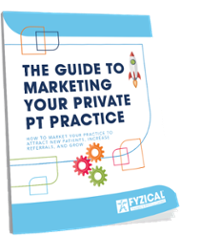 Get the Guide to Marketing Your Private Physical Therapy Practice!
Get the Guide to Marketing Your Private Physical Therapy Practice!
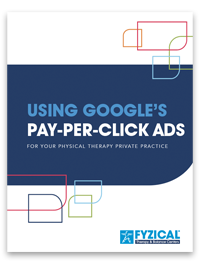
Learn how to use Google's Pay-Per-Click Ads to boost your patient counts!
Download this guide today and see what it takes to start advertising with the world's largest search platform - Google!


3 Ways physical therapy practice owners can use google to drive referrals to their Practice!
Do you know what it takes to drive referrals from your practice using Google? Find out how when you download this guide!


Reviews can make the difference between a patient choosing your practice, or going to your competition!
More than 70% of patients use online reputation before choosing a provider. Do you know how to get more reviews and manage the ones you already have? Download this guide and find out if reviews might be costing your practice!

Social media: do you need it? Are you on the right networks for a physical therapy practice?
Download this guide and learn what networks to leverage and how to take advantage of all the social traffic you can generate!


Content is king, but keeping track of several networks and the content you post can be an overwhelming task!
Download this free social media content calendar user guide and discover how to stay organized, plan ahead, and get the most out of the time you spend marketing your physical therapy practice.
Referral Relationships
location. Now is the time to begin your outreach to those potential referral sources. You will need to help them understand what services you provide and how you differ from other practices in the area offering similar services. You can even offer special incentives – such as a promise to get their patients in within a shorter time frame than a typical referral, or you include something free for every new patient – like a fall risk assessment, for instance.
Need help with referral management and building those crucial relationships?
We got you covered!
Learn tips and secrets on benchmarking and tracking referral sources and how you can improve these key performance metrics with small, simple changes! Download your copy here!
Get the Referral Toolkit, a suite of resources for physical therapy practice owners who want to learn and understand the referral relationships and metrics of a successful private practice:
- FREE GUIDE: Physical Therapy Referral Tracking and Management
- 14 Ways to Generate More Referrals in Your Physical Therapy Practice
- 16 Referral Sources Every Physical Therapist Needs to Know
- The Business Metrics that MATTER for Your Physical Therapy Practice - Are you Tracking Them?
Join Community Events
Effectively Running a Physical Therapy Practice
Choosing Software
- Compliance support for every reporting regulation
- Security for your patient data
- Digital Charting
- Order Entry
- Clinical Reporting
- Outcomes Reporting
-
Financial and operational reporting
-
Integrated Invoicing
-
Payment processing
-
Appointment calendar with automatic reminders
-
Client Management system
Financial Administrative Tasks
While many start-up practice owners initially take on the financial management and accounting responsibilities of their new business, it is advisable to invest in a bookkeeper or accountant who has experience with small healthcare businesses. The financial advice they can offer will save you time and money in the long run. They will also be skilled in making financial projections, giving you a good idea of the financial health of your practice.
Ready, Set, Grow Your Practice!
Cultivate a growth mindset from the beginning. While it is exciting to get your first few patients in your doors and on the books, constantly look at ways to improve every aspect of your practice to encourage its growth. Check in to your business plan regularly and keep a pulse on the ideas you initially had for your business.
Tracking & Analysis KPI's
Cash-Based Services
Products as an Extension of Therapy
Corrective Products
Modality Services – These services require some training and are not covered by insurance, like laser therapy and dry needling.
Ancillary Service Providers
Don't Go it Alone! Get the assistance you need to start a physical therapy practice and still remain an independent practice owner!
FYZICAL has helped nearly 500 practice owners start and run their own physical therapy practices. Why do it on your own when you can have a team of business and PT experts available whenever you need them?
Eliminate the stumbling blocks most new owners can't avoid. Check out our guide on starting a physical therapy practice with FYZICAL Therapy & Balance Centers!
Ready to Learn More?

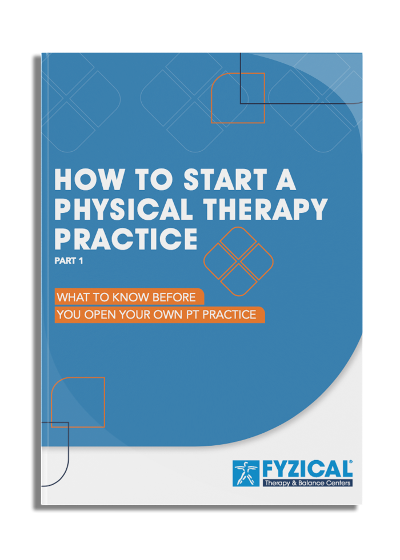


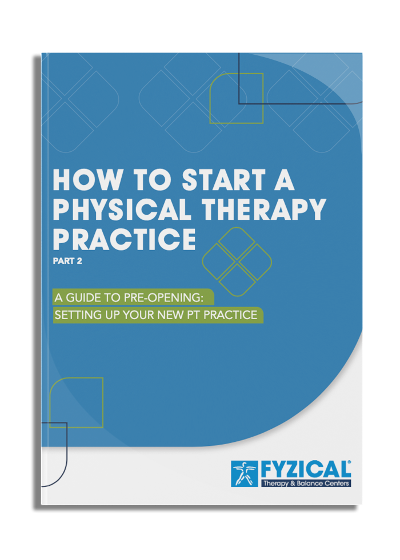

-1.png?width=200&name=location_eBook_thumbnail_1%20(1)-1.png)





